David Dunn’s music provides a world of intriguing interactions: a bird sings in counterpoint with electronic tones (Mimus Polyglottos, 1976), humans listen to themselves listening (Purposeful Listening in Complex States of Time, 1998), and pinion engraver beetles are stimulated with recordings of their own sounds (The Sound of Light in Trees, 2006). In Part 5 of David Dunn's 1975 work, PLACE, a particularly unique interaction occurs, one in which the environment interfaces with itself.
After four movements in which performers interact with and respond to sonic activity and resonances in their environment, this is the single movement in the work for which no performers are needed. Instead, the composer simply calls for two microphones to be situated within visual range of each other but with as much distance between them as possible. The signals from these two microphones are ring modulated (i.e., multiplied), and the resulting signal is projected from a central loudspeaker at a volume equal to that of the environment's ambient sound.1 Occurring near the middle of the work, this part of PLACE functions as a respite for the performers and as an opportunity for the environment to interact directly with itself via a transparent technological operation. This very operation, ring modulation, and the way in which David Dunn employs it in this setting can provide insight into the larger role technology plays in the composer's music. Indeed, these insights can be abstracted further to shed light on the ways in which Dunn approaches the relationship of humans to their environment.
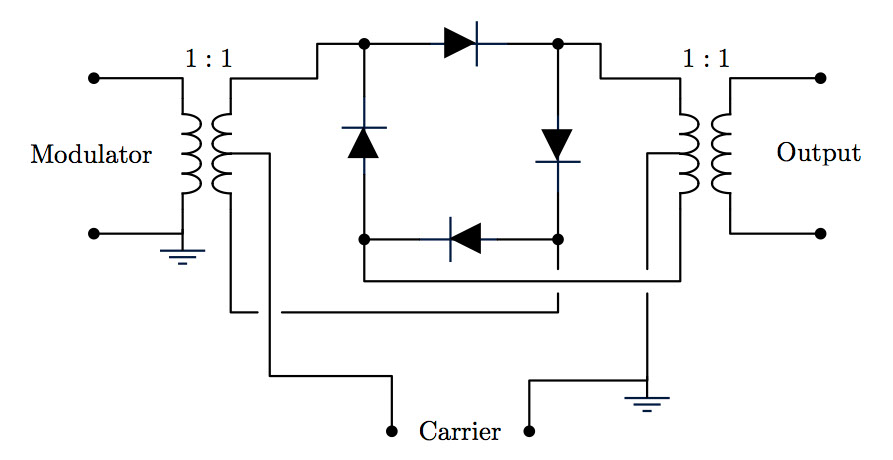
Ring Modulation
Ring modulation (RM) is a simple signal process which was first utilized in the 1930s to carry multiple communication signals over telephone cables, but began to be used for sound manipulation in the following decades. In RM, two signals are multiplied, causing the amplitude of the first signal (called the carrier) to be continuously changed by the second signal (called the modulator2). The result is the creation of two sets of sidebands: one consisting of the sums of the frequencies from each signal, and the other consisting of the differences.3 For example, if a 200 Hz sine wave and a 300 Hz sine wave are ring-modulated, the output would consist of energy at 500 Hz (sum tone) and 100 Hz (difference tone). If either (or both) of the signals has a richer spectrum consisting of many partials (like an orchestral instrument or a field recording), the output consists of the sum/difference of every frequency of the carrier and every frequency of the modulator, usually resulting in dense inharmonic spectra (i.e., tones with many more partials than those that appear in the overtone series). RM has been used extensively in the history of electronic music, perhaps most famously in Stockhausen's Mantra (1970) for two ring-modulated pianos. The name of the effect stems from the ring-like arrangement of diodes in the analog circuit that originally produced the effect.
The Commutative Property of RM
RM is part of a group of signal processes in which a pair of signals can be mapped onto one another, creating a single composite sound from two distinct sources. Similar techniques include other types of modulation (frequency modulation, pulse width modulation, cutoff frequency modulation) as well as spectral effects like cross synthesis. When compared with these effects, however, RM has a unique and defining characteristic: in most types of modulation, the modulating signal is acting on the carrier, imposing some sort of change upon it. If the carrier and modulator were to reverse roles, the result would be completely different (indeed, it could be thought of as being inverted).4 RM is notable in that if the carrier and modulator are flipped, the resulting sound is unchanged. This quality could be referred to as the “Commutative Property of RM,” and is the result of the process's simple arithmetic basis (multiplication): if signal A is ring-modulated by signal B, the result is the same as if signal B were ring-modulated by signal A (just as 3 x 4 = 4 x 3).
It is this commutative property that is so relevant to Dunn's work. RM, unlike most forms of modulation, is non-hierarchical. Rather than one signal forcefully imposing its characteristics onto another, both signals are responding to each other, becoming entwined into something that contains elements of each but is wholly something else.
For many composers, the natural world is a vast library of sounds, which can be selected, recorded, isolated, and de-contextualized for musical purposes. Pierre Schaeffer's concept of l'objet sonore is quite explicitly a sound "[independent] of its origin or its meaning" (Chion 32), which can be incorporated into a musical composition. This quasi-colonial approach of using recording technology to capture, excise, and repurpose natural sounds—an approach in which one party (the composer) dominates or acts on the other (the sound/its environment)—is anathema to Dunn's methods. Rather, he frequently uses electronics to create a reciprocal network between environmental sounds and the music in which they are (knowingly or unknowingly) taking part.5 Dunn doesn't act on the environment, he responds to it and—most significantly—allows the environment to respond in kind.
Such an exchange is clearly apparent in Mimus Polyglottos (1976). In this work, a collaboration with Ric Cupples, the composer presented a variety of auditory stimuli to the titular mockingbirds, in the hopes of engaging the birds in a kind of musical dialogue. "Rather than trying to exploit the sounds of the bird, I was interested in trying to challenge the bird's ability to mimic" (Dunn and van Peer 64). The initial experiments consisted of presenting the birds with prerecorded birdsong, which was not only successful in provoking a customary mockingbird response, but also allowed Dunn and Cupples to "acquire essential knowledge of proper mockingbird etiquette, how to approach the birds and what sort of proximity to maintain" ("Nature" 101). Subsequent attempts included presenting the subjects with electronically distorted birdsong, but his stimulus distressed the birds, causing them to disengage and cease singing. The final, most successful stimulus consisted of frequency-modulated square waves, a buzzy, overtone-rich waveform, which, while not sounding anything like the mockingbird's song, was designed to fit within the bird's frequency range and to contain sound-to-silence proportions characteristic of its singing patterns. This stimulus caused the birds to enthusiastically attempt to mimic different aspects of the electronic sound (timbre, pitch, rhythm), but, as Jennie Gottschalk points out, the bird "never settles either on a single aspect or on direct imitation, [demonstrating that] a great musical mind is at work, full of facility and flexibility, and creativity" (Gottschalk 167).
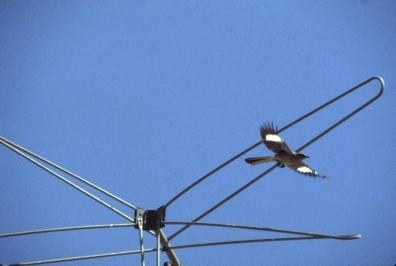
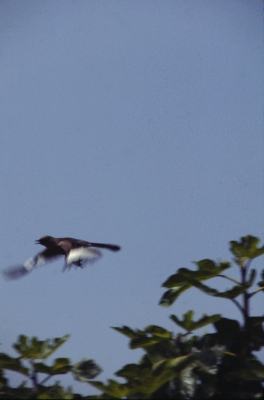
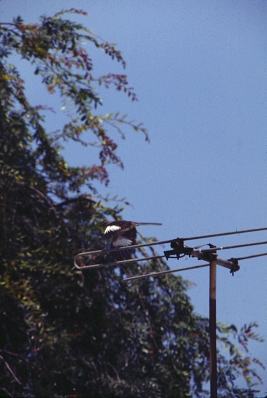
Spacetime Compression
As explained above, RM is able to create a cohesive output by multiplying two signals. Far from a simple "mix" of the two source sounds, RM creates a kind of mutant signal in which aspects of the originals (e.g., rhythm, contour, envelope) might be recognizable, but which is itself a distinct unity. Divergent melodies coalesce into a single inharmonic gesture; discrete strands of dialogue are alchemically fused into an alien utterance. RM has an uncanny ability to compress multiplicities into singularities.
This property of RM has analogs in a number of Dunn's works, particularly in PLACE. In that piece's aforementioned fifth part, the two microphones are positioned a great distance from one another (at Null Point's 2017 premiere realization at Silo City, the microphones were nearly 500 feet apart), capturing the ambience of two distinct locations. The RM of these two signals institutes a kind of spatial compression: two separate sonic spaces are fused together into a new, singular space. This is not a mere telescoping effect (i.e., magnifying or amplifying the sound of a distant space so it seems closer), but rather a collision of two spaces into a new central space. It's not that the distance between the two spaces shrinks, but that the very idea of their separation is extinguished. A listener standing near the central loudspeaker will hear not only the live ambience surrounding them but also the ambience of this new composite space, allowing them to occupy two (or three) spaces at once.
This idea of spatial compression manifests in Dunn's work even when RM is not involved. Several other movements of PLACE use recording technology to instigate different varieties of spatial compression. Part 1 requires a performer to spiral out from a central point while carrying a portable recorder; the recorded sound is then played back from a loudspeaker located back at the starting position. Part 3 is, in a sense, the opposite, calling for a recording to be made from a stationary microphone, which is then played back through a portable loudspeaker carried by a performer walking a perimeter around this same mic (which is creating a second, composite recording). In both movements, the recorded ambient sounds are played back at such a volume that their amplitude matches that of the realtime ambience, thereby obscuring the distinction between live and pre-recorded sound. These two movements not only superimpose recorded landscapes onto a "live" space, creating double- or triple-layered sonic environments, but they compress space even further by taking recordings of moving landscapes—recordings in which the microphone (or, in the case of Part 3, the loudspeaker being re-recorded) is moving through three-dimensional space—and playing them back through a stationary, one-dimensional loudspeaker. PLACE collapses space, casts off dimensions, and allows the listener to enjoy a kind of quantum superposition, like Schrödinger's cat, occupying multiple places at once.6
This dynamic is even more extreme in Part 4, in which several performers create ambient recordings of varying duration from a number of different positions in the same environment. These recordings are played back from a central location (and, in Null Point's realization, through the same loudspeakers), but are inevitably being re-recorded by other performers from various aural vantage points. This creates a far stranger act of spatial compression, in which multiple environments are superimposed, but are then re-recorded from different locations and superimposed further. The result is a kaleidoscopic assemblage of sonic environments that are repeatedly folded over on themselves, creating an Escher-esque hyperprism of space and sound. Just as RM can fuse two discrete signals into a single composite, PLACE creates unified spatial amalgamations from superimposed ambiences.
Audio recording not only captures the ambience of a particular space, but also that ambience as experienced in a particular time. Part 4's spatial-acoustic layer-cake demonstrates that Dunn is not simply compressing space, but time as well. In Part 4, snippets of time are captured by performers and then played back through loudspeakers, re-projecting them into a new time (the "present").7 This layered time is then re-captured again and again, from different locations and in different arrangements. The result is a fractal experience of time in which the same moment can be relived repeatedly, often from different vantage points and even at multiple times simultaneously. To listen to Null Point's realization of Part 4 is to experience a strange Lynchian time spiral, a web of intertwined Möbius strips in which one can experience an event, then turn a corner and re-witness the same moment from a different angle. It is a kind of temporal ecosystem—or, as Alvin Lucier once described Dunn's work, an "echo system" (Lucier 152).
PLACE is not the only work in which this temporal compression takes place. It is perhaps even more substantial in 1985's Entrainments 2. This elaborate piece was composed specifically for performance at Azalea Glen in California's Cuyamaca State Park. One of the many aspects of the piece involved three performers pre-recording stream-of-consciousness descriptions of the site days in advance of the performance, narrating events they witnessed from atop three mountain peaks. These recordings were mixed with static drones generated from an astrological chart for the time/location of the performance. During the performance, these spoken observations were played back into the environment, and as Dunn explains: "Observations made days before the performance coincided exactly with realtime events occurring during the performance. The resulting time and memory compression was experienced as if, on their prior visits, the speaking voices describe events that will happen in the future, and then those events do take place" ("Nature" 102). The piece's titular synchronization manifests not just as a temporal layering, but a melding of distinct points in time into a single moment. While PLACE compresses time by repeatedly folding it into a dense temporal multi-strata, Entrainments 2 approximates the fusion of RM by forging divergent times into a singular reality, a meta-time in which characters from the past witness events in the present. Dunn engineers a temporal experience unavailable in our usual perception of spacetime:
[These techniques are] based in a radical compression of time and space that no individuated consciousness could bear witness to. […] The sounds come from multiple locations and multiple positions in time. […] Overall, this work seeks to evoke a sense of the deep web of life that we are part of and to create an experience more akin to what the edge of science is telling us: that our sense of time as a flow from past to future is a perceptual illusion from which we cannot escape ("Philosophical Report" 29-30).8
Dunn claims that the perception of time as a flow from one discrete event to the next is illusory, and he uses sound art as a way of integrating past and present. The purpose of spacetime compression in his work is not a warping of time and space for its own sake, but is a means toward revealing connections to the listener, which their perception may not allow under everyday circumstances.
Integration into the Mind of Forest
The perceptual illusion with which Dunn is most concerned is the sense that "nature" is somehow external to or separate from that which is "human". He states above that his work is meant to awaken a "sense of the deep web of life that we are part of." Dunn is therefore not simply compressing time and space around the listener, but is attempting to dissolve that listener into the space itself. The point is not an erasure of the listener's subjectivity, but a new way of understanding the human as part of a larger, more interconnected biosphere. Audio technology in Dunn's work is a means toward the re-assimilation of the human into a more integrated perception of their ecology:
I am specifically interested in the total aural environment as a systemic phenomenon, hearing and working compositionally with that system as an interactive musical process. […] I want to use advanced technology as an opening up of perception and as a tool for increasing the environment's systemic complexity by re-including the human as an intrinsic part ("Mappings and Entrainments" 8).
Sometimes this is done very explicitly, as in 1980s MADRIGAL: (The Language of the Environment is Encoded in the Patterns of Its Living Systems). For this piece, Dunn recorded a minute of ambient sound in the Cuyamaca Mountains (the same site as Entrainments 2), and then transcribed those sounds into phonemes so they could be reproduced by seven human voices. Through this process, the composer integrates the environment's sound world into human physiology, remolding the ambience into sounds that fit within the limitations of the human vocal apparatus ("Expository Journal" 255). In a way, this is a commutative reversal of the relationship at work in Mimus Polyglottos: rather than "nature" improvising on a sound engineered by humans, humans are singing tones inspired by environmental sounds.9 However, the work also contains an element of spatial compression: in performance, the singers are accompanied by a filtered version of the original recording. The Cuyamaca's soundscape is thus reproduced in two different superimposed transformations (human voices; altered sound recording). MADRIGAL doesn't just reproduce ambient sound, it reshapes it in a way that integrates it into the human, and vice versa.
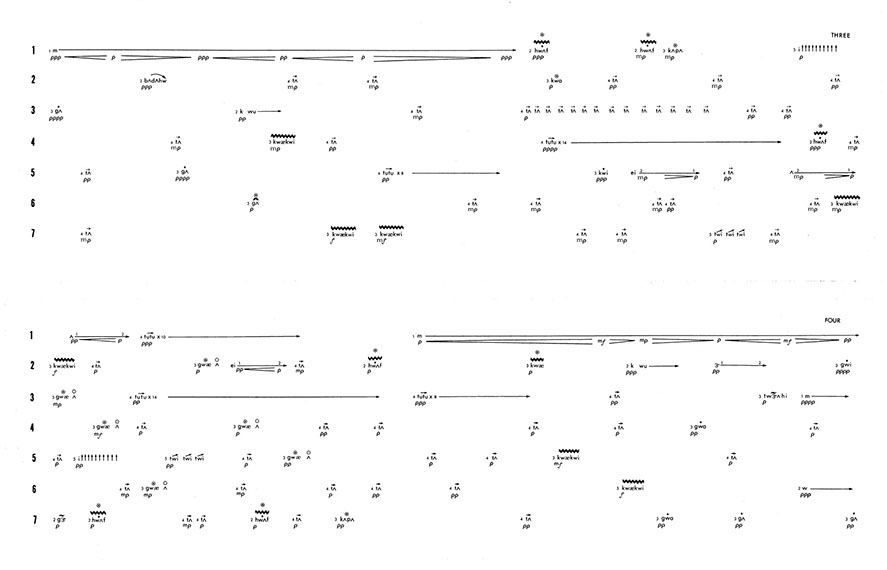
A similar process is at work in the first piece in the Entrainments series. For Entrainments 1 (1984), the composer started with two recordings made in Cuyamaca: one consisting of square waves being played into the site, the other consisting of a performer (Lizbeth Rymland) reciting stream-of-consciousness observations. These were fused together via a pitch-to-voltage converter that allowed the speech to become "tracings of ambience, while modulating the overall timbral spectra" ("Music, Language"). Four layers of such manipulated recordings were then played back into the performance site. In addition to the space-time compression inherent in such a process, there is a concerted effort to, as Dunn said above, re-include the human in the aural environment's interactive process. In doing so, the composer creates an RM-esque fusion of the human and non-human into something that cannot be heard as containing individual discrete subjectivities.
For Dunn, the aural environment is the one best-suited to achieving such an integration, due to what he perceives as the unique perspective offered by our sense of hearing:
When we look at the world, our sense of vision emphasizes the distinct boundaries between phenomena. The forward focus of vision concentrates on the edges of things or on the details of color as they help us to define separate contours in space. […] The sounds that things make are often not so distinct and, in fact, the experience of listening is often one of perceiving the inseparability of phenomena. […] While we often see something as distinct in its environment, we hear how it relates to other things ("Nature" 97).10
Dunn's comments contrasting the ability of the eyes and ears to distinguish between individuated stimuli recalls the whole/part binary so integral to Gestalt psychology, as explained by the German psychologist Kurt Koffka:
Our reality is not a mere collocation of elemental facts, but consists of units in which no part exists by itself, where each part points beyond itself and implies a larger whole. Facts and significance cease to be two concepts belonging to different realms, since a fact is always a fact in an intrinsically coherent whole. We could solve no problem of organization by solving it for each point separately, one after the other; the solution had to come for the whole. […] The whole is something else than the sum of its parts (Koffka 176).
Rather than reinforcing our understanding of the environment as consisting of discrete units (human and nature), Dunn seeks a gestalt integration that presents something entirely other than the sum (or difference) of its parts: an ecosystem brimming with intelligences of various kinds—human, animal, machine—and which humans are not separate from or in dominion over. "It is a different way of thinking about the world, a way to remind ourselves of a prior wholeness when the mind of the forest was not something out there, separate in the world, but something of which we were an intrinsic part" ("Nature" 97). Dunn's music is a reminder that we are deeply entwined with our ecology, returning us, in his words, to the "mind of the forest."
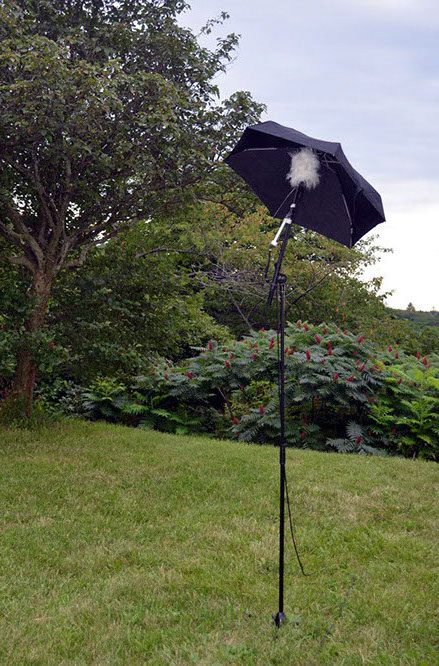
Techno-alchemy
Null Point's realization of PLACE's fifth part opens with a light rain shower. The performers, concerned for their equipment, quickly attached umbrellas to the microphone stands just before the movement's beginning. On the recording, one can hear a strange phenomenon: rain hitting the umbrellas on two microphones being ring-modulated to create a metallic percussive patter, interrupted on occasion by noisy bursts of wind and stabs of unplanned electrical glitches. Three discrete elements are involved in this interchange: the raindrops (nature) falling on the umbrellas (human artifacts) modulated by ring modulation (technological process). While each of these three factors can be heard and considered independently, together they reveal an elaborate interplay that would be easy to miss were it not foregrounded in such a way by the composer. Such interweaving between human and non-human is fairly ordinary, but rarely noticed. However, through Dunn's technological intervention they amalgamate into a striking composite. Consider also the surreal melding of voices and natural resonance in the aforementioned Entrainments 1, a work in which Dunn's uncanny alchemical fusion manifests alien sounds that estrange the relationship between human and non-human in an effort to re-reveal it to the listener. This is ultimately the goal toward which all these aforementioned RM-esque processes are working: through compressions of space and time, and through his works' mirroring of RM’s commutative properties of reciprocal interchange, the composer is able to present listeners with a fresh perspective on our relationship to the biosphere. For Dunn, this is indeed a kind of alchemy, or even further, a kind of magic:
One of the metaphors I have adopted to describe this work is that I am applying current technology toward a rediscovery of “natural magic.” In this case, it is a marriage of music and electronic technology, which serves to invoke a relationship to nature that is both ancient and contemporary (Wilderness" 381).
Invoking such a relationship is not an abstract idea, but one with specific political implications. Just as Koffka writes that the problems of the whole cannot be solved by addressing the parts separately, solutions to our current ecological crises will surely only come from a more integrated relationship to the biosphere. Dunn's use of technology in his sound art is not simply a philosophical exercise, but an attempt to recapture an understanding that may be essential to the survival of our ecology.
1 "Place two microphones separated as far as possible within visual range of each other in an open space. Utilize the signal from microphone one as the carrier input to a ring modulator and the signal from microphone two as the program input. The output signal from the ring modulator should be amplified and heard through a single loudspeaker placed centrally at an amplitude which matches the general ambience of the environment".
2 In Dunn's score, he refers to the modulator as the "program input."
3 RM is a type of amplitude modulation (AM). In most applications of AM, the original carrier signal can still be heard in the output; in RM, the carrier is suppressed, and only the sidebands (sums and differences) are heard.
4 The same is true with the cross-synthesis processes: the spectral envelopes from sound X are combined with the phases of sound Y. Inverting this process (i.e., utilizing the opposite parameters from each signal), will result in a sound with substantially different properties.
5 "I think that's where my work parts company with the major thrust of experimental music that has been concerned with the acquisition of nature sounds (birdcalls, for instance). […] My interest has been in recontextualizing the sounds in a serious, interactive manner—to go back into the environment and try to establish systems for providing evidence that these sounds are not just materials for human musicians" (Dunn and van Peer 64, emphasis added).
6 While Dunn's performers use recording technology to accomplish this spatial compression, it should be noted that humans may not be the only species capable of achieving such a feat. The composer himself relates an experience that implies mockingbirds may be space-compressors as well: "I was living at one end of Florida Canyon with the famous San Diego Zoo at the other end. Some nights I would be awakened by the inexplicable sounds of monkeys and tropical birds from my backyard. It took me awhile to figure out that the sounds didn't come from zoo escapees but from the mockingbirds who travelled up and down the canyon" ("Nature" 101). The mockingbirds were able to bring the zoo's ambience to Dunn's backyard with nearly the accuracy of a well-placed microphone, extinguishing the distance between the composer and the zoo.
7 It is, of course, true that the recording and playback of any sound event is a capturing and re-projection the past into the present. What is significant about Dunn's work is the way in which this re-projection is framed: whereas most recorded sound is presented as a focal point, a temporary alternative to the present, Dunn foregrounds the live ambient sounds as much as the recorded environments, fully integrating the two.
8 The composer is here referring to his 2006 piece The Sound of Light in Trees, but the insight is equally applicable to Entrainments 2.
9 It should also be noted that like the mockingbird in Mimus Polyglottos, Dunn is not simply creating a verbatim reproduction of the ambient sounds with human voices, but is instead compositionally reorganizing them "according to structural relationships intrinsic to the material itself" ("Expository Journal" 255).
10 It is worth noting that the contrast between the senses of hearing and vision that Dunn presents here is in fact part of a long-standing tradition in Western thought. Writers and thinkers including Plato, Saint Augustine, and more recently, Walter Ong, have articulated similar theories on the respective qualities of hearing and vision, each of them tending toward an idealization of hearing at the expense of vision. This phenomenology of the senses is critiqued by Jonathan Sterne (Sterne 2003), who refers to the regularly cited differences between them as the "audiovisual litany" (in reference to the idea's theological underpinnings). Sterne articulates this litany as a list of eleven distinctions between the senses, several of which are clearly at work in Dunn's approach: "Hearing is spherical, vision is directional; hearing immerses its subject, vision offers a perspective […]; hearing involves physical contact with the outside world, vision requires distance from it." Therefore, what is significant about Dunn's approach is not the transhistorical thinking undergirding it, but the specific ends toward which he is working: the gestalt integration of human and non-human intelligences, and the more explicit political and ecological repercussions of such integration.